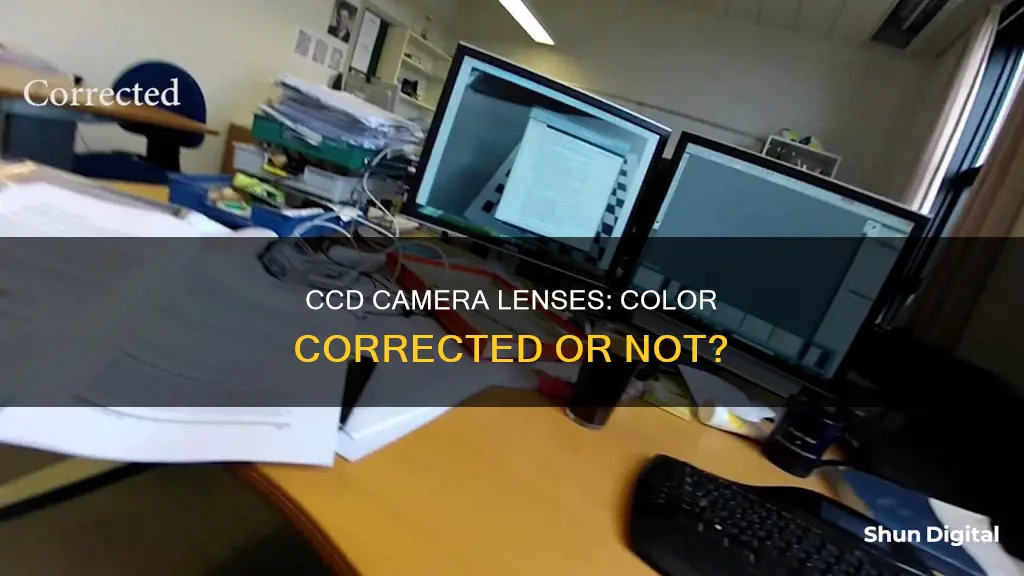
The popularity of older cameras with CCD sensors has increased recently, with many photographers praising their image quality and retro look. However, others are suspicious of this trend, believing it to be driven by nostalgia or a desire for novelty. While some claim that CCD sensors produce richer colours and more film-like images, others argue that this is not true and that any perceived differences in colour are due to improvements in colour filters and image processing algorithms over time.
In reality, the sensor's colour response is determined by the RGB filter array and how the digital data is processed into an image file. Standard lenses do not focus all colours, wavelengths, or frequencies of light onto the same image plane, and this can result in softer images or loss of focus. Infrared or IR-corrected lenses use low dispersion glass to reduce chromatic aberration and improve image sharpness.
Whether or not the lenses in CCD cameras are colour-corrected depends on the specific camera and lens in question, as well as the lighting conditions and the scene being captured.
What You'll Learn

CCD vs CMOS sensors: Are there differences in colour reproduction?
The decades-old competition between Charge Coupled Device (CCD) and Complementary Metal-Oxide-Semiconductor (CMOS) sensors has been a significant topic of discussion in the imaging world. While both technologies exploit the photoelectric effect to capture light and convert it into electrical signals, there are some differences in colour reproduction that are worth noting.
Colour Reproduction in CCD Sensors
CCD sensors have been known to produce high-quality, low-noise images with excellent light sensitivity. This is due to a special manufacturing process that allows CCD devices to transport charges across the chip without distortion. As a result, CCD sensors are often the preferred choice for applications that require superior image quality and low noise, such as astronomy, astrophotography, and medical and scientific imaging.
However, one drawback of CCD sensors is that they consume significantly more power than CMOS sensors, with power consumption up to 100 times higher. This has led to the phasing out of CCD sensors in many applications, including in space missions and machine vision systems, where low power consumption is a critical factor.
Colour Reproduction in CMOS Sensors
CMOS sensors, on the other hand, have traditionally been more susceptible to noise due to the presence of additional amplifiers and converters in the circuit. This can result in more noise in the output image. However, recent advancements in CMOS technology have led to improvements in image quality, with CMOS sensors now offering comparable performance to CCD sensors in many applications.
One advantage of CMOS sensors is their lower power consumption, making them ideal for mobile devices and other applications where power efficiency is crucial. CMOS sensors are also more cost-effective to manufacture, as they can be produced on standard silicon production lines. This has contributed to their widespread adoption in various imaging applications, including in digital cameras and mobile phones.
While there may have been some differences in colour reproduction between CCD and CMOS sensors in the past, with CCD sensors often considered to produce superior colour quality, these differences have become less pronounced over time. Modern CMOS sensors have made significant strides in colour reproduction, and in many cases, can match the colour output of CCD sensors. Ultimately, the choice between CCD and CMOS sensors depends on the specific requirements of the application, taking into account factors such as image quality, power consumption, cost, and speed.
Camera Lenses for DSLRs: Are They Piratical and Affordable?
You may want to see also

The impact of lens coatings on colour
Lens coatings can have a significant effect on the colour rendition of an image. Different types of lens coatings are available, each with its own unique impact on colour. Anti-reflective coatings, for instance, reduce reflections and glare, improving light transmission and resulting in clearer, more vibrant colours. Hardening film coatings enhance the durability of the lens surface, making it more resistant to scratches and other damage.
Additionally, lens coatings can introduce or reduce chromatic aberrations, which are caused by the different wavelengths of light bending at different angles as they pass through a lens. While lens coatings do not directly alter the dispersion qualities of a lens, they can minimise reflections and artefacts such as ghosting, flaring, and curvilinear distortion. This reduction in aberrations can lead to improved colour accuracy and overall image quality.
The choice of lens coating can also influence the colour temperature of an image. For example, a blue film lens coating can absorb over 99% of blue light and radiation, creating a safer viewing experience, especially for drivers. However, it may also result in a stronger reflection of blue light, causing a blue ghosting effect when driving at night. In contrast, a red film lens increases the reflectivity of red light, affecting light transmittance but having minimal impact on colour perception due to our lower sensitivity to red light.
Furthermore, lens coatings can enhance or reduce the UV protection offered by the lens. A green film layer, for instance, provides better UV protection and can help alleviate eye fatigue. This coating is often chosen as it is less noticeable on the lens surface.
It is important to note that the impact of lens coatings on colour is not limited to photography. In the field of eyeglass lenses, different coatings are applied to reduce glare, enhance UV protection, and improve the durability of the lenses.
While lens coatings can have a noticeable impact on colour, it is essential to consider other factors that influence colour rendition, such as the lens material, camera sensor technology, image processing algorithms, and lighting conditions.
Camera Lenses: Reselling and Buying Used
You may want to see also

IR-corrected lenses and their effect on image sharpness
IR-corrected lenses are designed to focus on both infrared and visible light simultaneously, making them ideal for night vision or custom IR applications. These lenses use low dispersion glass (LD glass), which significantly reduces chromatic aberration, a type of distortion where the lens fails to focus all colours to the same convergence point or image plane.
Standard lenses, on the other hand, do not focus all frequencies, wavelengths, or colours of light onto the same image plane. While they do focus most of the visible light, the softness or lack of focus in the captured image is more apparent in the near-infrared and infrared frequency range. This is because CCD and CMOS image sensors are sensitive to infrared light, and the inherent design of colour imaging cameras includes an IR cut filter.
When using a standard lens, switching from a normally lit environment to one with infrared illumination will result in a blurry image, requiring refocusing of the lens. IR-corrected lenses, however, should be used on both colour and monochrome cameras in all lighting conditions to achieve a consistently crisp and sharp image.
It is important to note that lenses designed for the visible range of light (approximately 420nm to 720nm) may exhibit a focus shift when used for near-infrared light (roughly 800 to 1100nm). This "longitudinal colour aberration" means that the focal length for an IR image differs from that of a colour image, resulting in one clear image and one blurry image.
Additionally, the quantum efficiency of the sensor, or its ability to receive near-infrared light, should be considered. Sensors may receive light in the near-infrared range at a lower efficiency, resulting in a darker image.
Renting Camera Lenses: Best Places to Get Them
You may want to see also

The advantages of CCD cameras over CMOS cameras
CCD (charge-coupled device) and CMOS (complementary metal-oxide semiconductor) image sensors are two different technologies for capturing images digitally. Each has unique strengths and weaknesses, giving advantages in different applications.
Image Quality and Noise
Historically, CCD sensors produced higher-quality images with less noise due to their analog charge transfer process and thicker epilayers. However, recent advancements in CMOS technology have led to the production of CMOS image sensors with image quality comparable to CCD sensors.
Power Consumption and Cost
One of the primary advantages of CMOS sensors is their lower power consumption, which can be up to 100 times less than CCD sensors. This makes CMOS sensors ideal for large-scale production and applications where power efficiency and cost are crucial, such as in mobile devices and interplanetary spacecraft. The integrative nature of CMOS sensors also makes their manufacturing process more cost-effective.
Speed and Frame Rates
CMOS sensors offer faster processing and higher frame rates compared to CCD sensors, making them ideal for applications requiring high-speed imaging, such as machine vision systems and robotics. This increased speed is due to the parallel processing capabilities of CMOS sensors, which allow for the rapid readout of electrical signals.
Near Infrared Imaging
CMOS imagers are generally tuned for high-volume applications that only image in the visible spectrum. They are not very sensitive to near-infrared light and are engineered to be as insensitive as possible in this range. CCD sensors, on the other hand, can be fabricated with thicker epilayers, making them much more sensitive to near-infrared light.
Ultraviolet Imaging
Ultraviolet photons are absorbed very close to the silicon surface, so UV imagers must not have layers that impede the absorption of UV photons. Modern UV imagers are backside thinned, but achieving stable UV response requires specialty surface treatment for both CMOS and CCD sensors.
Time Delay and Integration (TDI) Imaging
TDI imagers are used in machine vision and remote sensing and operate similarly to line scan imagers, capturing multiple snapshots of a moving object and adding them together to create a stronger signal. CCD TDI imagers combine signal charges, while CMOS TDIs can combine either voltage or charge signals. CMOS voltage-domain TDI summing can be cost-effective for lower numbers of row summing, but for the most challenging applications, charge-domain CMOS TDI delivers the highest performance.
The Truth About Camera Lenses: Glass or Plastic?
You may want to see also

The disadvantages of CCD cameras
CCD stands for "charge-coupled device", and it is an electronic module capable of transporting electronic charges. Willard Boyle and George E. Smith invented the technology in 1969 at Bell Laboratories. CCD sensors are widely used in professional, medical, and scientific applications where high-quality image data is required. However, there are some disadvantages to using CCD cameras. Here are four to six paragraphs detailing the disadvantages of CCD cameras:
CCD cameras have slower readout speeds compared to CMOS sensors. This is because CCD sensors have only one central A/D converter that digitalises the data, whereas CMOS sensors have individual converters for each pixel, allowing for faster processing. This slower readout speed can be a disadvantage in applications that require high-speed image capture, such as sports photography or wildlife photography.
CCD cameras also tend to have higher power consumption than CMOS sensors. This is due to the requirement for active cooling of the CCD sensor to maintain optimal performance. The higher power consumption can lead to shorter battery life, which may be a concern for photographers who are frequently shooting on location or away from power sources. Additionally, the need for active cooling adds to the complexity and cost of the camera system.
Another disadvantage of CCD cameras is the lack of direct pixel access. Unlike CMOS sensors, which allow for random access to individual pixels, CCD sensors must be read out serially, which can slow down image processing and limit the flexibility of the camera system. This serial readout also contributes to the larger size and more complex layout of CCD cameras compared to CMOS-based alternatives.
Furthermore, CCD cameras are more susceptible to smearing and blooming effects when overexposed. Blooming occurs when the pixels in the brightest parts of the image overflow, resulting in vertical streaking. This can degrade the overall image quality and is a particular concern for photographers who frequently shoot in high-contrast lighting conditions or who require a wide dynamic range.
While CCD cameras offer high sensitivity and low noise, they may not be suitable for all applications. CCD sensors are typically more expensive than CMOS sensors, especially for cameras with zero defective pixels, which are critical for certain scientific and medical applications. The higher cost is due to the more complex manufacturing process and the requirement for additional electronics to support the CCD sensor. Therefore, CCD cameras may not be a cost-effective option for photographers on a budget or for applications where high-end features are not necessary.
In conclusion, while CCD cameras offer excellent image quality and performance, they also come with several disadvantages, including slower readout speeds, higher power consumption, lack of direct pixel access, greater susceptibility to smearing and blooming effects, and higher costs. These disadvantages should be carefully considered when choosing between CCD and CMOS camera systems, as the ideal choice will depend on the specific requirements and budget of the user.
The Ultimate Camera Lenses for Professional Photography
You may want to see also
Frequently asked questions
CCD stands for charge-coupled device. It is an integrated circuit containing an array of linked capacitors. CCD sensors are a major technology used in digital imaging.
CMOS stands for complementary metal-oxide-semiconductor. CMOS sensors are generally used in consumer and professional digital cameras. CCDs are said to have richer colours and give a more retro look than CMOS sensors.
Colour correction may be needed if you are using a standard lens. Standard lenses do not focus all colours of light onto the image plane. However, if you are using an infrared-corrected lens, this type of lens uses low dispersion glass to reduce chromatic aberration.
The best CCD camera depends on your requirements. The Kodak Professional DCS 645 Pro Back is said to produce the best colours, but it is expensive and rare. The Konica Minolta Maxxum 5D/7D is a cheaper alternative that produces interesting colours.
CCD sensors are said to have less noise than film cameras and produce softer images with less resolution.







